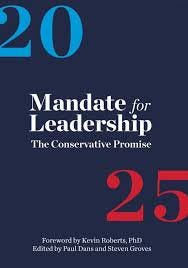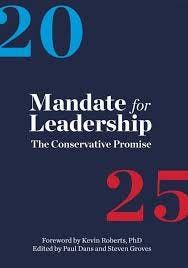Justice in 2025
In the last several weeks Project 2025 has been a frequent topic. Among its 1000+ pages is a chapter on the Justice Department. What might Justice look like in 2025 and beyond?
Justice Briefs is a weekly newsletter devoted to federal criminal prosecution. The federal government’s evolution over the last 230 years has given federal prosecutors significant discretion. Few realize it exists and even fewer know how it is used. Justice Briefs aims to make federal prosecutions and prosecutors more accessible to the general public. Please help me in this endeavor by subscribing and sharing with others.
Justice in Brief
In the Central District of California, a television securities analyst was indicted on multiple counts of securities fraud for making false statements in connection with his public comments.
In the Southern District of Texas, an Indian national was indicted for selling a counterfeit version of Keytruda, a cancer treatment drug.
In the Southern District of New York, two Chinese men entered guilty pleas to acting as unregistered foreign agents for China. The duo attempted to influence the IRS to drop the tax exempt status for Falun Gong, a banned religious organization in China.
Justice - 2025
As the 2024 Presidential Election draws closer, people have been talking about Project 2025, the Heritage Foundation’s blueprint for the next conservative presidential administration. Among its many chapters and ideas, Chapter 17 focuses on the Justice Department. It proclaims that the Justice Department has “lost its way in recent years.” (p545) It has lost its way because “large swaths of the department have been captured by an unaccountable bureaucratic managerial class and radical Left ideologues…” (p545) This has left to “inattentiveness to is core functions.” (p545) Fixing this requires “a holistic, energetic, leadership-driven effort to remedy the damage…” (p547) This requires “committed direction from the department’s political leadership…” (p547)
Regardless of what one thinks about the upcoming election, the Justice Department chapter provides a critique of the current Department policies and provides alternatives. Should someone win the election who supports these ideas, how might Justice change? What, if anything would it do differently?
Before looking further into the proposal, it is important to know the writer. Gene Hamilton currently serves as the Vice President and Legal Counsel for America First Legal. That group was created in 2021 by former advisor to President Trump, Stephen Miller. The group is “fighting back against lawless executive actions and the Radical Left.” Prior to joining America First Legal, Hamilton served as an advisor to Donald Trump’s first Attorney General, Jeff Sessions. Understanding this background provides important context to the language Hamilton uses in his plan for the Justice Department.
Hamilton’s plan for the Justice Department divides into two categories. The first is protecting public safety, which he claims the Justice Department no longer does. The second is upholding the rule of law, which he claims the current Justice Department undermines. This is where the perspective comes into play. Hamilton’s approach is not an objective critique but based on political perspective and ideology. Those on the other side of the political perspective would completely disagree with his conclusion. Thus, we must look deeper into his proposals.
First, in terms of protecting public safety, Hamilton identifies five areas where the Justice Department must change course. (pp552-557) On the surface, his proposals do not generate significant opposition. He wants the Justice Department to (1) enforce immigration laws, (2) combat criminal enterprises, (3) protect federal civil rights, (4) combat foreign espionage, and (5) focus on violent crime. The issue is not identifying these priorities but how the priorities are implemented.
The problem of violent crime provides a window into policy implementation. Hamilton asserts, without citation, that violent crime “has increased across the United States.” (p552) Thus the Department “must make actually reducing violent crime a priority.” (p552) The question becomes how to do this. Hamilton answers this, at least to an extent. He takes aim at reform efforts implemented by many state-level prosecutors. After explaining that these reform efforts have diminished effective law enforcement, Hamilton says the Justice Department “has a special obligation to restore law and order in such districts.” (p552) From this premise, he provides three more concrete proposals. The first is to “use applicable federal laws to bring federal charges against criminals when local jurisdictions wrongfully allow them to evade responsibility for their conduct.” (p553) The second is to “where proper and warranted under federal law, initiate legal action against local officials—including District Attorneys—who deny American citizens the ‘equal protection of the laws’ by refusing to prosecute criminal offenses in their jurisdiction.” (p553) Undoubtedly, this holds appeal to those opposed to these state-level prosecutors.
This leads to an important critique of the program. Hamilton does not explain, beyond rhetoric, how the Justice Department has this authority. What possible charges could the Department bring against a state-level district attorney who exercises legitimate prosecutorial discretion to not charge particular cases. Of course, this is not Hamilton’s concern. It is more that these District Attorneys no longer prosecute marijuana offenses or shoplifting offenses. Regardless of the merits of those decisions, the Justice Department has no mechanism to intervene. At best it could prosecute such cases itself. Marijuana is still illegal under federal law. Shoplifting, unless there is violence involved, would not fall under federal law. This reveals that Hamilton’s proposal is more rhetoric than reality.
Turning to the rule of law aspect, Hamilton focuses more on constitutional litigation than criminal prosecution. Even so, he proposes actions related to prosecution. His primary concern is the Justice Department’s use of the Freedom of Access to Clinic Enterances Act (FACE). He argues that the Department has enforced this in a biased fashion by prosecuting religious groups who peacefully protest at abortion clinics while ignoring violent attacks on pregnancy resource centers that counsel abortion alternatives. (p558) A Justice Department list clearly shows more prosecutions from conduct at abortion clinics, it is not accurate to say that these have been peaceful protests. Many involve blockades and others allege threats, property damage, or assaults at the clinics.
In a related matter, Hamilton advocates initiating prosecutions under the Comstock Act. Currently located at Title 18, Sections 1461 and 1462 of the United States Code, the law prohibits mailing or sending through interstate commerce materials or medicine that would aid in performing an abortion. While the law was a dead letter following the Supreme Court’s recognition that abortion was a constitutional right. The Court’s removal of this recognition has made the 1873 Comstock Act enforceable again. Not surprisingly, current Justice Department leadership has not enforced it. Hamilton’s proposal for a conservative-led Justice Department includes enforcing this law.
Hamilton concludes his look at the rule of law by objecting to third party requests for politically motivated prosecutions. He points to letters sent to Attorney General Garland asking for federal assistance to protect schools officials from threats of violence. (p564-565) From Hamilton’s perspective, these are efforts to subvert people’s freedom of speech. Thus, he would disallow such activity. He claims these are politically motivated prosecutions. (p564) This leads to the inference that he objects to federal assistance in this instance (recall, he wants to intervene in state prosecutions) because he has a political disagreement with the people who sent the letter.
All of this is to say that Hamilton’s approach is more ideological and political than he would admit. He is not opposed to politics influencing Justice Department policy, he just wants it to be his political perspective. Though he couches it is broad and innocuous language, his proposals and his conception of the rule of law are more influenced by ideology than neutral law enforcement.
With that said, this is not to say he should not do this. Those on the other side do the same thing. Political parties run on particular policy agendas. Choosing that party means choosing that agenda. A similar “Radical Left” agenda would take the polar opposite view and call it upholding the rule of law and the rights of the people.
This piece focuses on the policy goals advanced by Project 2025’s vision for the Justice Department. There are two other overarching themes in the document that will be next week’s focus.
I hope you enjoyed this issue and that it made you stop and think. I would love to hear any comments, questions, concerns, or criticisms that you have. Leave a comment or send a message! Also, if you enjoyed this or if it challenged your thinking, please subscribe and share with others!



